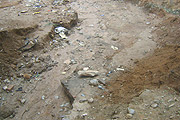Soil conservation involves finding appropriate ways to ensure that soil quality is preserved. When the society is to be educated about soil conservation, the most important area to tackle is how our soils loose their fertility, causes leading to that loss, ways of maintaining and improving it so as to have a qualitative and quantitative yield.


Soil conservation involves finding appropriate ways to ensure that soil quality is preserved. When the society is to be educated about soil conservation, the most important area to tackle is how our soils loose their fertility, causes leading to that loss, ways of maintaining and improving it so as to have a qualitative and quantitative yield.
Soil conservation is not only important in areas of agriculture but it also matters on maintaining the landscape and enhancing the beauty of the land.
In my lower secondary school class, the Agriculture teacher made it an important note for students to fully understand soil conservation.
In retrospect, I now understand why. Our teacher knew that such information would contribute towards the development through educating the society as Agriculture is the economic activities of most African countries.
In Africa land is mostly being affected by soil erosion. Soil erosion is the washing away of top soils. This normally depends on the landscape in areas where it affects, if the area is too steep, soil erosion is most likely to heavily affect the land.
Soil erosion normally occurs when wind or running water washes away the top soil. This leads to loss of nutrients which may have resulted in high yields.
It also causes crust making it hard for rainwater to be absorbed, hard for seeds to break through, and gullies leading to improper leveling and planting.
The amount of soil erosion which occurs in an area depends upon certain factors ie the speed at which the ruining water or wind moves across the area with the abundance of plant life that is grown their.
Poor farming methods like over-grazing where a small piece of land is used to for grazing a big number of animals leading to quick smashing away of the vegetation, hardening top soils hence soil erosion.
Over cultivation which includes mono-culture whereby a piece of land is used in cultivating of only one type of crop season to season, year to year. Therefore causes of soil erosion are both natural and human.
There are several methods used by farmers to limit soil erosion. Most of these can be adapted for use by home gardeners, too. The first method is conservation tillage.
This simply means to leave a portion of vegetation in the ground, instead of stripping everything away. In a garden, it could mean leaving a band of grass around your garden, so that the soil stays within the boundaries you’ve set.
Contour farming is another method that’s useful in preventing and controlling soil erosion by water runoff. It’s done by planting along the slope of a hill, following the natural contours of the land, instead of straight up and down or across.
You could plant a cover crop when your land is not in use. Besides providing protection for your land, many cover crops are nitrogen-fixers, meaning they absorb nitrogen from the air and deliver it back to the land.
If you have a problem with wind erosion, try planting a windbreak. A windbreak can be a row of trees, bushes or even a fence. Anything that will keep high winds from sweeping across your land can help prevent wind erosion.
Land should also be given some time to rest, although it may appear to be expensive in the short run since based on the African perspective people do not have enough land but this will prove to be productive in the long run in that it allows the soils rest and regain the lost nutrients.
Keeping your soil healthy is a very important step to take in preventing soil erosion. Soil that is rich in organic matter has better structure and is less susceptible to being washed or blown away. To keep your soil healthy, add plenty of compost each year and don’t over-till when you are planting.
Mulching: the covering of top soils so that the speed at which the running water and wind is reduced is also another way of preventing soil erosion and maintaining soil fertility in that with time after rain the mulch rots and turns into natural fertilizers.
Artificial fertilizers can also be applied to the land which has already lost its fertility so as to improve on the productivity of the soils. Whenever soil erosion occurs, it normally leads to creation of swamps.
Therefore it’s also beneficial to employ a technique in order to avoid water in the garden land. This can also be done by making trenches from that particular area to drain away the excess water.
Preventing soil erosion is always preferable to attempting to control or reverse it later. Once an area of land has been eroded, it’s sometimes impossible to correct it. By following these steps, you can do your part in maintaining and preserving our environment.
Ends


